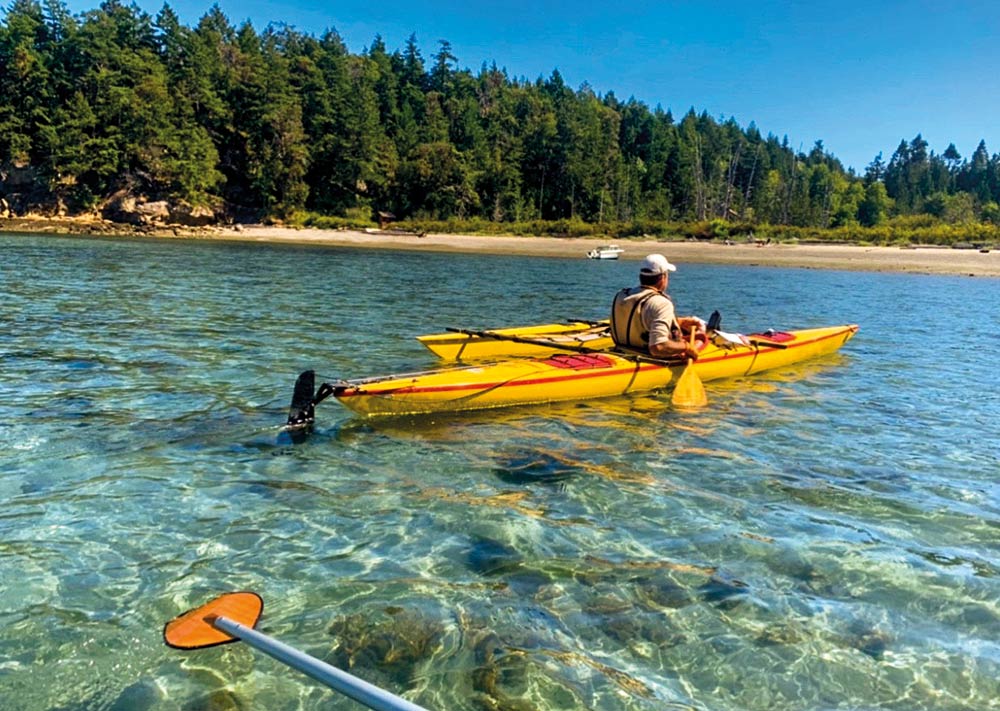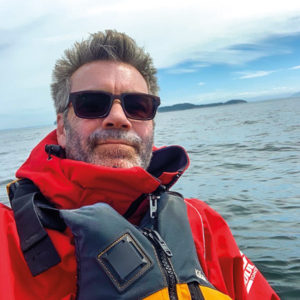In any normal year, I’d typically get two or three rowing trips under my belt in my home away from home, the Pacific Northwest. But the shutdown changed all of that—2020 is not a “normal” year. This year, I was grateful for one. And, imperfect though it was in certain ways, it delivered on all fronts that matter.
I successfully sheltered in place without leaving the county in which I live—Marin, California. Luckily, I truly love my home turf of Tomales Bay. Conveniently, the bay is walking distance from my house and it’s beautiful, but it has limitations. It’s only about one mile wide and fifteen miles long, so it can get a bit Groundhog Day-ish. When I need to get in some serious miles and experience an adventure, I go north.
I was quite reluctant to go anywhere due to the pandemic, but I convinced myself that I could go on this trip and not be close to anyone. The first logistical hurdle of my journey was the road trip from Inverness to my friend John’s house on Guemes Island. Owning a VW diesel really helped because I knew I’d only need to stop once for fuel during the 900 mile drive.
I loaded the car with all my gear including plenty of water, food, masks, and hand sanitizer. I did not want to make any unnecessary stops. Then, I was off to Portland where I had reserved a yurt on a farm for one night to split the drive. I chose the yurt so that I wouldn’t have to interact with any humans, only the pigs and goats on the farm. After a peaceful night’s sleep, I got up and drove straight to Guemes Island and was greeted by John and his wife, Deb, who were the most gracious hosts I could ask for.

John was to be my traveling partner on this trip, and was generous enough to provide our boats. He chose to paddle his 19-foot Kevlar Easy Rider, which he paddled in the first R2AK. I decided to row his 18-foot Odyssey Rantilla Front Rower, which John built for the Seventy48 Race. Fortunately, I rowed his boat last year, so I was familiar with the forward facing rower. I typically row backwards in my Maas Aero Shell or my Angus RowCruiser. I figured it would be best if we were both looking in the same direction for a week, instead of one of us forward and the other backwards.
I prefer to map out my trips beforehand, although I never seem to stick to the plans. We had a general sense of when we wanted to launch and where we would camp. The main goal was to get to Sucia Island, as I had never been there before and have heard a lot of good things about it.
We loaded up John’s two boats, and our trip was officially underway. It was great to finally be up north, where there was open water and space. It was freeing to trade my workday mask for sunglasses and sunscreen while on the boat. We made a loop from Guemes and camped at Matia, Patos, Jones, Blind, Doe, and Cypress Islands. It was a bit too crowded at both Sucia and Jones Islands, but we were pleasantly surprised everyone was practicing social distancing and wearing masks.
Each island had its unique charm: the hiking trail at Matia was lush; Patos had a historic lighthouse; although small in size, Blind Island offered some campsites and was a short row to Orcas Island to restock our beer and ice. The first days of the trip went without a hitch, and then there was Doe Island.
Nearing the end of our trip, we rowed around little Doe Island to try and find a decent location to beach the boats for the night. Unfortunately, there weren’t any ideal spots available, so we rested the boats on two logs and tied them to a tree—fingers crossed.
All was well until around 11:30 that night when a kayaker, who was camped closer to our boats, said, “I think you guys should check on your boats. We can hear them banging together.” John and I both jumped out of our tents at the same time. Still dressed in our long johns, we ran down the trail to find both boats full of water and waves crashing over them. We spent the next couple of hours bailing the boats, collecting our jetsam from the beach, and watching the wave activity. Eventually the water receded enough, and we felt we could head up and change out of our wet clothes and try to get back to sleep. The next morning we woke up to assess the damage. One of the Easy Rider’s outrigger poles punched four holes in the Odyssey. The three holes located just above the waterline were concerning enough, but the real threat was the fourth one, which would be underwater.

At this point, we still had two crossings and one more night of camping on Cypress Island to go. Fortunately, John had packed duct tape in a dry bag, and we both had a bit of ingenuity and can-do attitude. What else were we going to do? We used the duct tape to patch the holes, making the repairs both inside and outside the boat.
Setting off in the damaged craft, I’m confident that I made the crossing in record time. I stared at the patch job the entire time I rowed. I was ready to bail, if needed. Amazingly, the duct tape held perfectly.
Upon reaching Cypress, we hiked up to Eagle Cliff to get a birds eye view of the crossing that the duct-taped boat successfully endured. I took a moment to appreciate the exquisite San Juan Islands vista, and breathed a sigh of relief.
Our DIY repair job held for our final day as we completed our loop back to Guemes. As soon as this journey was over, the next adventure began—getting back home to California and evacuating my family from our home due to nearby fires. There really is nothing “normal” about this year.
Looking back on it, though, this was another great rowing trip to the Pacific Northwest; as they always are. How could it not be when exploring new waters from a small craft with a cherished friend? Stories and memories are seldom forged without mishap, and row-cruising tends to be memorable—even when there isn’t so much duct tape saving our bacon.






